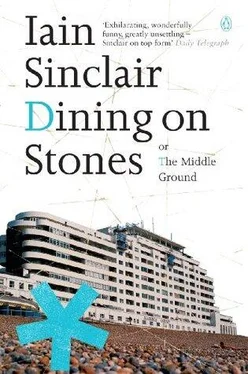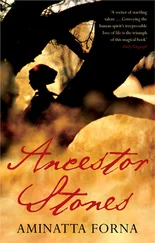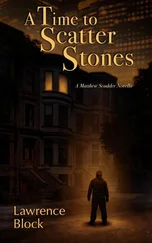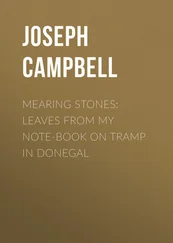Drin, who was staring out of the window, grabbed Achmed’s arm. Reaching across Kaporal to do it.
‘He come. Mocatta send him. Is good.’
Good move.
The guy with the wheels, going for inconspicuous, had parked halfway across the pavement, right on the double yellows. A fat gull settled on the black roof, challenging the driver to shift him. Nobody would give this vehicle a second glance: in downtown Havana. A 1956 Dodge Coronet, two-tone. (Kaporal had seen the photo in an art book.) A smoke bucket. Delicious with chrome. Hastings cars were notable for their modesty, pre-owned Nissan Primera, Peugeot 309 5DR Saloon (£600 o.n.o.), Ford Fiesta. This thing, in the Old Town, by the shop that did jukeboxes and Jack Lord Hawaii Five-O shirts, might get away with it. Exposed here, on the Grand Parade, it was like taking a scarlet bubble car to a gangland funeral in Chingford Mount.
The driver couldn’t even lock the door. He dropped his keys and spent five minutes crawling after them. He was totalled. He saw Achmed, through the window, standing up, waving. He ducked back into the car for cigarettes and dark glasses. Then, sniffling perniciously, rolling his shoulders, he made his pizza joint entrance.
Reo Sleeman.
Alby’s little brother. The crazy one. The wet dream his old mum scraped from the blanket. Reo was the reason Kaporal was on the coast . If he didn’t look him in the eye, the Essex boy might not remember. A London face in this setting. Reo was incapable of holding two concepts in his head at the same time. But here he was, on his feet, swaggering. Mocatta’s man. With instructions for the hired help, wops, redskins. The traditional wrappers of bodies in tarpaulin.
The seagull.
On the car roof.
A steady gaze. Out of the window. That’s best.
Kaporal knew just whose face it had borrowed. Supercilious, sub-aristo. Arsenic pale, awkward. A tourist and a local. The gull was a fugitive soul, a suicide. It might blink at the lowlife — or take off on the wing, swoop over the waves, return to the rock where the gang congregated, melting post-Permian stone with their acrid crap. Beautiful in a way. But trapped in the wrong species, wrong body.
The gull had the face of Virginia Woolf.
Night in the Old Town. Livia couldn’t shake off the feeling that she was being followed. In London — not her place — she was the follower, in control of the drama. Of her fear. Good fear, edge. She welcomed it. The purlieus of railway stations, parks under tungsten light, tower blocks in dark wildernesses. Queer domestic rituals, human glimpses, against a backdrop of monolithic alienation.
For example: a man asleep, head sunk on chest, in an underground train. Windows like portholes in a submarine.
Dusty curtains, folds on a sepulchre, framing the aperture of another window, half submerged, swallowed by the pavement, in a back alley of the City.
An egg-shaped table-lamp (seen from inside the room). A high window. Diffused light, the nimbus: blue dawn breaking over a railed and frosty garden.
A girl walking through an underpass. Three categories of illumination: wall lights (pearly as crushed aspirin), traffic (red/gold), night at a distance, in the tunnel’s mouth.
Trees. Livia loved her trees. City trees. The isolation. Sodium glare on crinkled leaves.
Livia was good, better than her mentor. Better than Jimmy Seed. The photograph, in this case, outperformed (in subtlety, in heart ) the mechanical intelligence of the artist’s hand. Jimmy calculated, measured up, delivered. Livia waited.
Olivia Fairlight-Jones. Aspirational Celtic hyphen. Known to her associates as ‘Ollie’. Father dead? According to rumour. Mother wasn’t talking. It took Ollie years to tease out the real story. The reason for reverting to (and revising) mother’s maiden name. A stepfather with marine-factoring business in Brightlingsea, sold up at the right time. Retirement to Portugal. Ollie also had a husband (acquired and lost at the University of Essex). The photography came later. As did Jimmy. The work as an assistant. Nights clubbing in Dalston and Shoreditch. Information of no great consequence to Livia, she left it out of her gallery biogs: date of birth, list of shows.
But these are the facts that should, in a proper work of fiction, be scattered decorously through the text; revealed, oh so casually, in oblique conversation. By letter, phone call or fax. Engendering necessary suspense, admiration for the technical skill, the discretion, of the author. There should be an element of uncertainty, tease. Let’s get it out of the way. Norton, in his narratives, was a premature ejaculator. By conviction.
Know it, tell it. Blabbermouth.
Livia rather fancied doing a Julia Margaret Cameron. In reverse. Giving up photography when she lost her spark, when she was old (around forty) — moving to Sri Lanka. To marry and settle down with a planter (if they still had them), or scholar (Sanskrit, Pali). Children. And trees. Plenty of trees.
Warm thoughts on a cold night. Her visibility, despite the dark, gender-unspecific clothes, heavy boots, coming away from the railway station, was alarming. London didn’t care. It was busy, preoccupied, on the edge of breakdown. Once the beggars, and the smiling, excuse-me-do-you-have-a-minute clipboard tarts, the chuggers, had packed it in, bedded down in doorways, the city belonged to anyone who walked it. The coast was a very different proposition, a half-life of tranquillised opportunism, reflex crimes enacted for the benefit of (out-of-service) CCTV cameras.
Glue-sniffers without the energy to sniff.
Scrawny youths who headbutted their way into already vandalised cars.
Ram-raiders who hit depressed video outlets. Without the car. And made their getaway with an armful of empty cases.
Coastal lowlife were under no obligation to disguise their interest, their fingering of the imaginary weft, the smooth pelt of this fragrant newcomer.
Their prey.
A young woman from elsewhere with a large bag. A bag loaded with readily puntable kit.
Jackal signals. Red eyes in the shadows.
Hastings had a tradition to uphold. Photoshops. Cameras. Racks and racks and racks of rectangular views. Self-regarding images of picturesque beauty. Hastings was the operational base of postcard magnate Fred Judge. And the amateur lensman George Woods. Who, with his unwieldy plate camera and sturdy tripod, did some useful stalking of fisherfolk and excursionists.
Hastings, Ollie recognised, was seductive. Arriving by car or by train, the same sudden hit: light. Shore and sky. Cliffs and steep streets, unexpected angles. Reflections in windows.
With his liking for half-plate negatives, Mr Woods was never less than half conspicuous. He favoured (as a subject) working men, their portraits being taken by somebody else. A local hack. Artisan in a cricket cap. The camera seen by the camera. Dissociation of sensibility.
The prints, unrecognised in Woods’s lifetime, established a marine franchise, The Cockney Day Out’. Traditions have to be invented. The scenes he captured are the ones that disappear first: a quality in the live / dead faces, nakedness, exposure to that cyclopean eye. Vulnerability . As they ignore the monster, unconvinced by its potency. The pathos of this respectable man of business, bearded photographer, Victorian, trousers rolled up, standing in the sea, on a rock — so that he can catch the promenade, the loungers on the beach, the cliffs. Girls who have lifted their skirts to reveal voluminous underpinnings.
Three young ones, wild-haired. You can hear what they’re saying. One of them looks at the camera, at Woods. The oldest girl, spotty ribbon on straw boater, is issuing instructions: her tragic spectacles and serious knees. Senior sister or young mother? Mind your manners. Don’t stare .
Читать дальше












